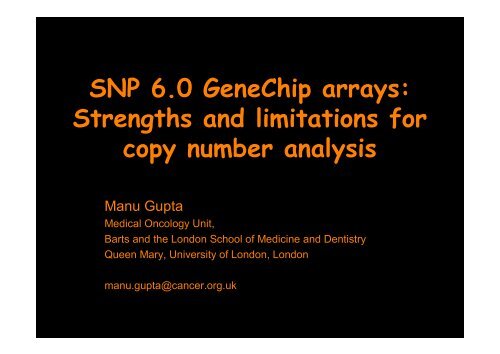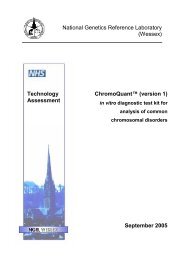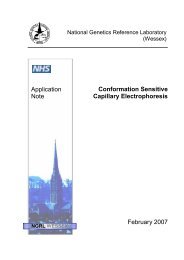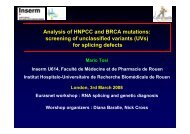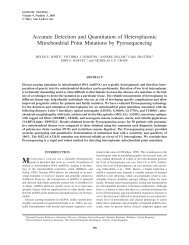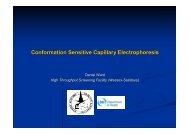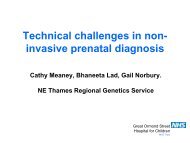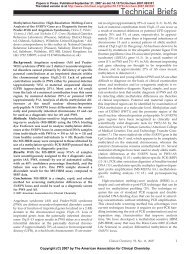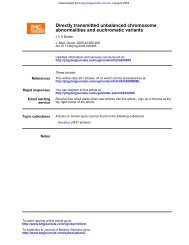SNP 6.0 GeneChip arrays: Strengths and limitations for copy ...
SNP 6.0 GeneChip arrays: Strengths and limitations for copy ...
SNP 6.0 GeneChip arrays: Strengths and limitations for copy ...
You also want an ePaper? Increase the reach of your titles
YUMPU automatically turns print PDFs into web optimized ePapers that Google loves.
<strong>SNP</strong> <strong>6.0</strong> <strong>GeneChip</strong> <strong>arrays</strong>:<br />
<strong>Strengths</strong> <strong>and</strong> <strong>limitations</strong> <strong>for</strong><br />
<strong>copy</strong> number analysis<br />
Manu Gupta<br />
Medical Oncology Unit,<br />
Barts <strong>and</strong> the London School of Medicine <strong>and</strong> Dentistry<br />
Queen Mary, University of London, London<br />
manu.gupta@cancer.org.uk
Major applications of <strong>SNP</strong> <strong>arrays</strong><br />
– GW Linkage analysis : Hum Mol Genet 2006, 15, 2903<br />
– GW Association studies : Nature, 2007, 447, 661<br />
Nature, 2007, 447, 1087<br />
– Copy number <strong>and</strong> : Genes Chr. & Cancer, 2008, May 27 [Epub]<br />
LOH estimation PNAS 2008,105,6708<br />
Nature 2007, 446, 758<br />
Major suppliers <strong>for</strong> <strong>SNP</strong> <strong>arrays</strong>:<br />
– Affymetrix <strong>and</strong> Illumina
Affymetrix <strong>GeneChip</strong> ® <strong>arrays</strong><br />
Hybridization based<br />
– Mapping 10K 2.0 :10,000 <strong>SNP</strong>s<br />
– Mapping 100K (2 x 50K) : 2 x 50,000 <strong>SNP</strong>s<br />
– Mapping 500K (2 x 250K) : 2 x 250,000 <strong>SNP</strong>s<br />
– GW Human <strong>SNP</strong> <strong>arrays</strong> <strong>6.0</strong> : 900,000 <strong>SNP</strong><br />
+ 900,000 CN probes
Mullighan et al, Nature, 2007<br />
Paulsson et al, PNAS, 2008
Map of UPDs in 450<br />
AML samples<br />
Gupta et al,<br />
Genes Chromosomes <strong>and</strong> Cancer, 2008<br />
UPD<br />
Loss<br />
Gain
The <strong>6.0</strong> array - Design<br />
• Over 1.8 million markers of genetic variation<br />
– 906,600 <strong>SNP</strong>s<br />
• 482,000 from the 500K <strong>arrays</strong><br />
• Another 424,000 <strong>SNP</strong>s (HapMap, mitochondrial,<br />
recombination hotspots, X <strong>and</strong> Y chr)<br />
– Over 946,000 nonpolymorphic probes <strong>for</strong> Copy<br />
number detection<br />
• 202K probes in known CNV regions<br />
• 744K probes “tiled evenly” along the genome
The <strong>6.0</strong> array - Design<br />
PM A<br />
MM A<br />
PM B<br />
MM B<br />
500K <strong>arrays</strong><br />
Resolution:<br />
1 marker every<br />
700 bp on average<br />
CN probe<br />
<strong>SNP</strong> probes on <strong>6.0</strong> array
Experimental protocol <strong>for</strong> <strong>6.0</strong> <strong>arrays</strong>
<strong>6.0</strong> <strong>SNP</strong> array results: Chr17<br />
4<br />
2<br />
1<br />
Sample<br />
0067<br />
4<br />
2<br />
1<br />
Sample<br />
0065
Increased resolution is the strength of <strong>6.0</strong> <strong>arrays</strong>:<br />
Sample 69_D: UPD6p<br />
10K<br />
250K<br />
Nsp<br />
250K<br />
Sty<br />
<strong>6.0</strong><br />
Loss of ~65 Kb
Detection of MLL-PTD in an AML sample by <strong>6.0</strong> <strong>arrays</strong><br />
Size: 5Kb17Kb<br />
43 CN probes, 3 <strong>SNP</strong> probes
Genotype in<strong>for</strong>mation allows QC of patient samples
CNVs detected in human genome<br />
(Fig: Chr 17)<br />
4 normal samples compared against a pooled control
Analysis can further be made complex by<br />
Constitutional CNVs/ segmental duplications<br />
Germ Line<br />
Tumor sample<br />
Chr A Chr B Chr A Chr B<br />
4 copies of marker 2 copies of marker<br />
A deletion on Chr B would also<br />
reflect a heterozygous deletion<br />
on Chr A, even though Chr A is<br />
normal
Limitation I: Overlapping probes<br />
considered as independent
Limitation I: Overlapping probes<br />
considered as independent
Replicates increase signal to noise ratio:<br />
avoid false positives <strong>and</strong> true negatives<br />
029/030<br />
Run 1<br />
029/030<br />
Run 2<br />
Summation<br />
of above<br />
two
Limitation II: Probes in repeat elements
Limitation II: Probes in repeat elements
Take home message<br />
• <strong>SNP</strong> <strong>6.0</strong> are very good <strong>arrays</strong> to detect<br />
“micro events”, if used carefully<br />
• Control <strong>for</strong> overlapping probes <strong>and</strong><br />
probes in repeat regions should improve<br />
analysis<br />
• Running experiments in duplicate<br />
increases power of analysis; but is<br />
expensive!
Acknowledgements<br />
Bryan Young<br />
Jean Baptiste Cazier<br />
Manoj Raghavan<br />
Kajsa Paulsson<br />
Patients <strong>for</strong><br />
their samples..!!<br />
Contact: manu.gupta@cancer.org.uk<br />
bryan.young@cancer.org.uk


